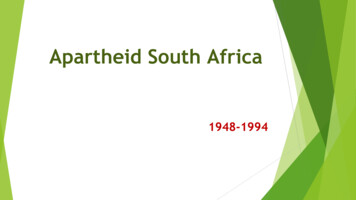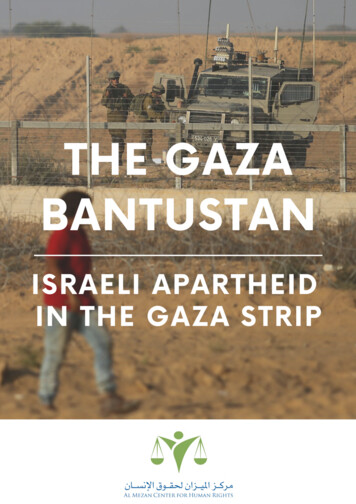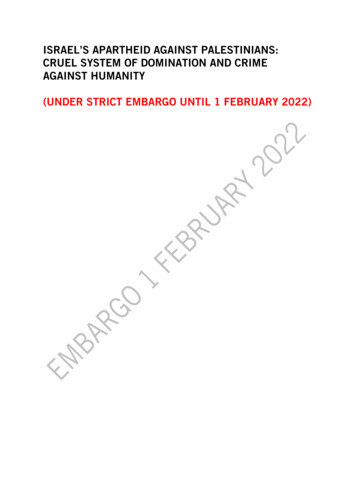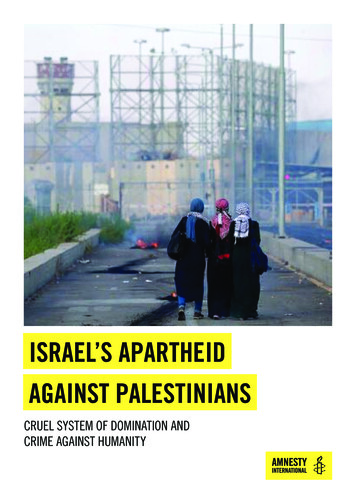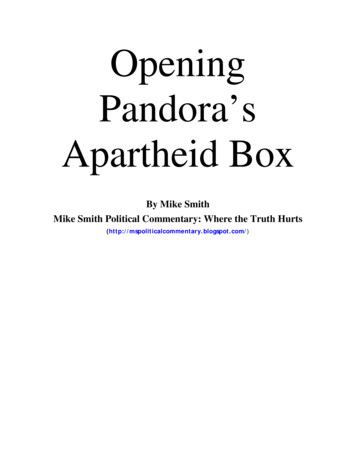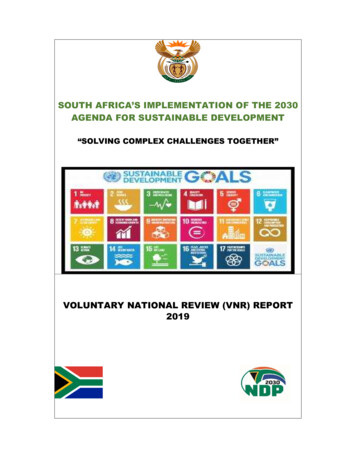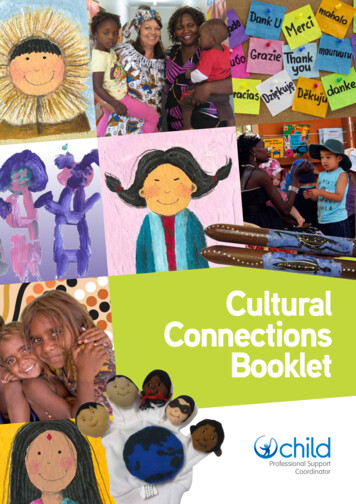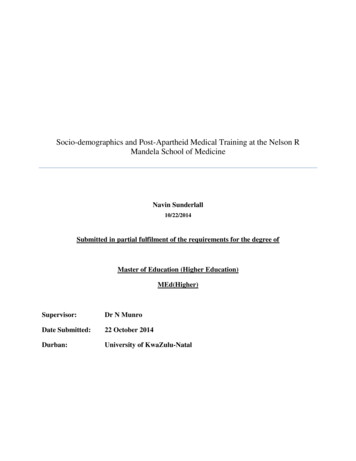
Transcription
Socio-demographics and Post-Apartheid Medical Training at the Nelson RMandela School of MedicineNavin Sunderlall10/22/2014Submitted in partial fulfilment of the requirements for the degree ofMaster of Education (Higher Education)MEd(Higher)Supervisor:Dr N MunroDate Submitted:22 October 2014Durban:University of KwaZulu-Natal
ABSTRACTThe Nelson R Mandela School of Medicine (NRMSM) is an important stakeholder in thetraining of doctors. Like other South African medical schools, NRMSM’s programmes andpolicies are guided by institutional and governmental legislation in response to a series of postapartheid challenges such as transformation, redress, access and success. South Africa’s healthworkforce is dependent on the number (and profile) of post-secondary school leavers who gainaccess to the medical training platform and achieve success therein. It is questioned whetherNRMSM is achieving the legislated targets for the training of doctors in post-apartheid SouthAfrica. The research reported in this dissertation documented the socio-demographic profiles ofrace, gender, age, educational qualifications, and background and geographic origins (and thechanges therein) of applicants and admitted students to the MBChB programmes between 1995and 2005. In addition, it documented the number of students admitted from disadvantagededucational backgrounds as well as their success rates. This quantitative, objectivist andpositivist research study involved secondary data collection from existing databases from theUniversity of KwaZulu-Natal, the Department of Basic Education and other sources. The datawas cleaned and subjected to descriptive and correlational statistical analyses. The results fromthe analyses revealed that, between 1995 and 2005, there was an increase in the ratio ofapplicants to admitted students, and the majority of applicants and admitted students were Black,female, matriculants (aged between 18-21 years) and residents of KwaZulu-Natal fromadvantaged (fee-paying) schools. NRMSM has admitted a small number of applicants from nonfee paying schools. However, when compared to a first year failure-rate of 10.5% for admittedstudents from fee-paying schools, admitted students from non-fee paying schools experienced anaverage failure rate of 35%.At NRMSM, race continues to be an important admission criterionand higher numbers of females and matriculants from KwaZulu-Natal are admitted. Theseredress targets enhance gender and race representivity in the health workforce in the province, asstudents admitted from KZN are more likely to remain in KZN after qualification. Althoughincreased access to medical higher education within the non-fee paying school cohort alsocontributes to national access and redress initiatives, the high failure rate among this cohortimplies that additional resources should be provided to improve success in this group of students.i
DECLARATIONThis dissertation is submitted in partial fulfilment of the requirements for the degree of:Master of Education (Higher Education), MEd (Higher), the Graduate Programme in theSchool of Education, College of Humanities and Social Science, University of KwaZulu-Natal,Pietermaritzburg, South Africa.I, Navin Sunderlall, declare that1.The research reported in this dissertation, except where otherwise indicated, is my original research2.This dissertation has not been submitted for any degree or examination at any other university.3.This dissertation does not contain other persons’ data, pictures, graphs or other information, unlessspecifically acknowledged as being sourced from other persons.4.This dissertation does not contain other persons' writing, unless specifically acknowledged as beingsourced from other researchers. Where other written sources have been quoted, then:a.Their words have been re-written but the general information attributed to them has beenreferencedb.Where their exact words have been used, then their writing has been placed in italics and insidequotation marks, and referenced.5.This dissertation does not contain text, graphics or tables copied and pasted from the Internet,unless specifically acknowledged, and the source being detailed in the thesis and in the Referencessections.6.This dissertation has been checked for originality and the originality report is contained inAppendix 1 of this document.Navin SunderlallStudent Name27 October 2014DateStudent SignatureDr Nicholas MunroSupervisor Name27 October 2014DateSupervisor Signatureii
DEDICATIONThis dissertation is dedicated to my wife, Prathna Bhola, and my children Kiaav and Shiuli fortheir understanding and patience during the writing of this document.iii
ACKNOWLEDGEMENTS1. Professor Charlotte Mbali: my original supervisor when I first started this project in2007; for her guidance and understanding, encouragement and mentorship.2. Mr Quintus van der Berg of City Couriers. Thank you for the list of postcodes. Theclassification of the regions and geographical origins of the students would have beenimpossible without it.3. Mr Deepak Singh (DUT). Thank you for the assistance with the statistical analysis.4. Dr Nicholas Munro, my current supervisor. Thank you for the academic input, guidance,understanding and patience. This would not have been possible without your valuableassistance and mentorship; for this I am eternally grateful.iv
LIST OF cademic Performance ScoreCollege of Health SciencesCommunity Service ProfessionalDurbanDepartment of Education and TrainingDepartment of Higher Education and TrainingDivision of Management InformationDepartment of EducationDepartment of HealthDepartment of LabourEducation Management Information SystemHealth Professions Council of South AfricaHealth Systems TrustHealth Sciences Placement TestIntegrated Tertiary SoftwareProvince of KwaZulu-NatalKwaZulu-Natal Department of HealthBachelor of Medicine and Bachelor of Surgery5-year MBChB degree (2001-2009)6-year MBChB degree (-2000)Medical SchoolNational Norms and Standards for School FundingNelson R Mandela School of MedicineNational Senior Certificate for Degree StudiesPietermaritzburgStudent Management SystemTruth and Reconciliation CommitteeUniversity of Cape TownUnited KingdomUniversity of KwaZulu-NatalUniversity of LimpopoUniversity of NatalUniversity of Natal – Medical SchoolUnited States (of America)University of Witwatersrandv
CONTENTSABSTRACT. iDECLARATION . iiDEDICATION . iiiACKNOWLEDGEMENTS . ivLIST OF ACRONYMS . vCONTENTS. viLIST OF TABLES . xiLIST OF FIGURES . xiiGLOSSARY.xiii1. Access: exposure to higher education, gaining admission to, or, being admitted to highereducation, from previously and currently (educationally) disadvantaged persons. This is related to nonfee paying schools. .xiiiCHAPTER ONE: BACKGROUND AND CONTEXT . 11.1.INTRODUCTION . 11.2.BACKGROUND AND CONTEXT. 21.2.1.Higher (Medical) Education and Healthcare Delivery in Post-Apartheid South Africa . 21.2.2.The Platform for the Training of Doctors . 31.2.3.A Brief History of the Nelson R Mandela School of Medicine (NRMSM) . 41.2.4.A Brief History of the Admission Policies at NRMSM. 41.2.5.A Brief History of the Programmes (and Admission Criteria) offered at NRMSM . 51.3.FOCUS AND SIGNIFICANCE. 51.3.1.Access and Redress at NRMSM . 51.4.RESEARCH QUESTIONS. 71.5.CONCLUSIONS . 7CHAPTER TWO: LITERATURE REVIEW . 92.1.INTRODUCTION . 92.2.INTERNATIONAL EXPERIENCES and TRENDS IN APPLICANT PROFILES . 92.2.1.Numbers and Ratios . 102.2.2.Gender . 10vi
2.2.3.2.3.Age and Graduate Entry Programmes . 11THE SOUTH AFRICAN EXPERIENCE . 112.3.1.Socio-demographic Profiles - The University of Cape Town Experience . 122.3.2.Measures of Disadvantage . 122.3.3.Access and Redress in South Africa. 142.4.HEALTH WORKFORCE DISTRIBUTION. 152.4.1.The Global Picture . 152.4.2.The South African Perspective . 162.5.THE SOUTH AFRICAN SCHOOLING SYSTEM and the PREDICTORS OF SUCCESS . 182.6.THEORETICAL FRAMEWORK . 192.7.CONCLUSION . 20CHAPTER THREE: RESEARCH METHODOLOGY . 213.1.INTRODUCTION . 213.2.THIS RESEARCH . 213.3.DATA COLLECTION . 213.4.DATA CLEANING and MANIPULATION . 223.4.1.DMI Databases . 223.5.VARIABLES, STATISTICS AND REPORTING . 233.6.DESIGN LIMITATIONS . 243.7.ETHICS . 243.8.CONCLUSION . 25CHAPTER FOUR: RESULTS . 264.1.INTRODUCTION . 264.2.APPLICANT PROFILES . 274.2.1.NUMBER OF APPLICANTS. 274.2.1.1.Overall Number of Applicants to the NRMSM . 274.2.1.2.Number of Applicants per Programme . 274.2.1.3.Number of Repeat Applicants . 284.2.2.RACE . 294.2.2.1.Overall Race Profile of Applicants . 304.2.2.2.Race Profile of Applicants per Year and Programme . 304.2.3.GENDER . 31vii
4.2.3.1.Overall Gender Profile of Applicants . 314.2.3.2.Gender Profile of Applicants per Year . 324.2.4.AGE . 324.2.4.1.Overall Age Profile . 324.2.4.2.Age Profile in 18-21 year Age Category . 334.2.4.3.Number of Matric and Mature Applicants in 18-21 year Age Category . 334.2.5.MATRIC and MATURE APPLICANTS. 344.2.5.1.Overall Number of Matric and Mature Applicants . 344.2.5.2.Matric and Mature Applicants per Year. 354.2.6.GEOGRAPHICAL ORIGINS OF APPLICANTS . 364.2.6.1.Provincial (KZN vs. non-KZN) Distribution of Applicants. 364.2.6.2.Racial Profile of Applicants by Provincial Origins . 374.2.6.3.Regional Origins of KZN Applicants . 404.2.6.4.Racial Profiles of Applicants from KZN by Regions. . 414.2.7.APPLICANTS FROM DISADVANTAGED (Non-Fee Paying) SCHOOLS. 414.2.7.1.KZN vs non-KZN Applicants from Non-Fee Schools . 424.2.7.2.Racial Profile of Applicants from Non-Fee Paying Schools . 434.2.8.4.3.SUMMARY OF APPLICANT DATA . 43ADMITTED STUDENT PROFILES . 444.3.1.NUMBER OF ADMITTED STUDENTS . 444.3.2.RACE . 454.3.2.1.Overall Race Profile of Admitted Students . 464.3.2.2.Racial Profile per Year – Newly Admitted Students . 474.3.3.GENDER . 474.3.3.1.Overall Gender Profile. 484.3.3.2.Gender Profile per Year . 484.3.4.AGE . 494.3.4.1.Overall Age Profile of the (First Year) Student Population . 494.3.4.2.Matric and Mature First Year Students in 18-21 Age Category . 504.3.5.MATRIC and MATURE FIRST YEAR STUDENTS . 504.3.5.1.Overall Number of Matric and Mature Students Admitted. 504.3.5.2.The Quota of Matric and Mature Students . 51viii
4.3.6.GEOGRAPHICAL ORIGINS of the STUDENT POPULATION . 524.3.6.1.The Provincial Residential Origins of the Student Population . 524.3.6.2.Racial Profile of Admitted Students by Province . 534.3.6.3.Profile (Race and Number) of Students who are Residents in KZN . 544.3.7.STUDENTS ADMITTED from DISADVANTAGED SCHOOLS . 544.3.8.SUMMARY of ADMITTED STUDENTS DATA . 554.4.SUCCESS RATES OF STUDENTS FROM DISADVANTAGED EDUCATIONAL BACKGROUNDS . 564.4.1.PROPORTION OF ADMITTED STUDENTS TO APPLICANTS per COHORT . 564.4.2.SUCCESS RATES OF STUDENTS FROM FEE PAYING AND NON-FEE PAYING SCHOOLS . 574.4.3.SUMMARY . 584.5.STATISTICAL CORRELATIONS . 594.5.1.NUMBERS AND RATIOS of APPLICANTS AND ADMITTED STUDENTS . 594.5.2.RACE . 594.5.3.GENDER . 594.5.4.AGE . 604.5.5.MATRIC and MATURE . 604.5.6.GEOGRAPHICAL ORIGINS . 604.5.7.FEE-PAYING vs. NON-FEE PAYING SCHOOLS . 614.5.8.FIRST YEAR RESULTS. 61CHAPTER FIVE: DISCUSSION . 625.1INTRODUCTION . 625.2.NUMBER OF APPLICANTS AND ADMITTED STUDENTS . 625.2.1.APPLICANT to ADMISSION RATIO . 625.3.RACE . 655.4.GENDER . 665.5.AGE . 685.6.MATRIC and MATURE . 695.7.GEOGRAPHICAL ORIGINS . 705.8.FEE-PAYING vs. Non-FEE SCHOOLS (DISADVANTAGED SCHOOLS) . 705.9.RESULTS OF FIRST YEAR MBChB STUDENTS . 715.10.CONCLUSION . 72CHAPTER SIX: SUMMARY, CONCLUSION and RECOMMENDATIONS. 74ix
6.1.INTRODUCTION . 746.2.SUMMARY . 746.3.IMPLICATIONS AND RECOMMENDATIONS . 766.4.FUTURE RESEARCH. 786.5.CONCLUSION . 79REFERENCES . 80APPENDICES . 82Appendix 1: Turnitin Originality Report . 82Appendix 2: Gate Keepers Letter . 83Appendix 3: Ethics Approval . 84x
LIST OF 24.4.35.1.1The Numbers and Percentages of Applicants per Year (1995-2005) .Race Profile of Applicants per Year .Number of Applicants 18-21 year Age Category .Description of KZN Regions .Regional Origins of KZN Applicants Racial Profile of Applicants from KZN .Applicants from “No-fee” Schools per Year (1995-2005) Enrolled students, New Admissions and Repeat Students per Year .The Number of Matric and Mature Students .The Distribution of Admitted Students by Provincial Origins .Racial profile of Students Admitted by Province .Number and Racial Profile of Students Admitted by KZN Region Number of Students Admitted from “Non-Fee paying” Schools per Year Admissions and Results of Students Admitted per Year .Students who Failed per Year from Fee-Paying and Non-Fee Paying schools.Failure Rates per Programme .Distribution of Matric and Mature Students in the 18-21 Age Category .2730334040414244515253545557575869xi
LIST OF FIGURESFigureDescription/Title of .3.54.3.64.3.74.3.85.1.15.1.2The Number of Applicants per Programme Percentage of Reapplications per Year (1995-2005) .Race Profile of Applicants per Year (1995-2005) .Overall Gender Profile of Applicants (1995-2005) .Gender Profile of Applicants per Year (1995-2005) .Age Profile of Applicants (1995-2005) .Matric vs Mature Applicants in 18-21 Age Group .The Number of Matric vs Mature Applicants (1995-2005) .The Number of Matric vs Mature Applicants per Year (1995-2005) .The Geographical Origins of Applicants (1995-2000) The Geographical Origins of Applicants per non-KZN Province .Number of Applicants by Race per Region The Number of Applicants from Non-Fee Paying Schools by Province The Racial Profile of Admitted Students (1995-2005) .Race Profile of Admitted Students by Year (1995-2005) . .Gender Profile of Students Admitted to NRMSM (1995-2005). .Gender Profile of Newly Admitted Students (1995-2005) .The Age Profiles of Admitted Students (1995-2005) The Number of Matric and Mature Students Admitted . .The Percentage of Mature Students Admitted per Year (1995-2005) .The Number of Students Admitted per non-KZN Province (1995-2005)Ratio of Vacancies to Applicants per Year (1995-2005) Number of Applicants and Students Admitted per Age Category 368xii
GLOSSARYThe following terms are used in the study and should be taken to mean:1.Access: exposure to higher education, gaining admission to, or, being admitted to highereducation, from previously and currently (educationally) disadvantaged persons. This isrelated to non-fee paying schools.2.Redress: strategy to increase admission to higher education by previously disadvantaged(on racial grounds) groups.3.Success: refers to progression through the various modules in the first year of the MBChBprogrammexiii
CHAPTER ONE: BACKGROUND AND CONTEXT1.1.INTRODUCTIONThe education and training of a doctor in South Africa is a process which involves the interactionof various national and provincial government departments, higher education institutions, healthcare facilities and communities. Each of these departments, institutions, facilities andcommunities experience a series of post-apartheid challenges such as transformation, access andsuccess, attaining equitable socio-demographic profiles, and health workforce distribution. Forindividuals and families, becoming a doctor is a long, expensive and complex process, whichcommences in the secondary schooling phase and the challenges associated with gaining accessto the medical schools. Once admitted to medical school the next challenge facing learners istheir preparedness for the programmes and then the associated financial burden. For medicalschools and universities the challenges include attracting, retaining and graduating theappropriate numbers of appropriately qualified learners from the appropriate groups in order tosatisfy not only their own policies and requirements but that of the government. For thegovernment departments that provide the legislative framework for the education and training,employment and deployment of doctors in South Africa the challenges include: funding,adequate staffing levels in the public sector as well as the appropriate deployment of suitablyqualified doctors to all regions of the country. Despite these challenges, South Africa isproducing doctors on an annual basis; however, it is questioned whether this process is efficient,equitable, and just. Does the number of doctors produced equate to the socio-demographicprofiles of the country and is this sufficient to meet the growing demands of health careprovision in the country?In light of the above, the Nelson R Mandela School of Medicine (NRMSM) in the College ofHealth Sciences (CHS) at the University of KwaZulu-Natal (UKZN) is an important stakeholderin the education and training of doctors in KwaZulu-Natal (KZN) and in the South Africancontext. Many of the challenges (as detailed above) experienced by the various departments,institutions, facilities, communities and individuals are relevant to and affect all stakeholders invarying degrees, and each stakeholder has sought answers and solutions to address thechallenges.The research reported in this dissertation ho
Socio-demographics and Post-Apartheid Medical Training at the Nelson R Mandela School of Medicine Navin Sunderlall 10/22/2014 Submitted in partial fulfilment of the requirements for the degree of Master of Education (Higher Education) MEd(Higher) Supervisor: Dr N Munro Date Submitted: 22 October 2014 Durban: University of KwaZulu-Natal
